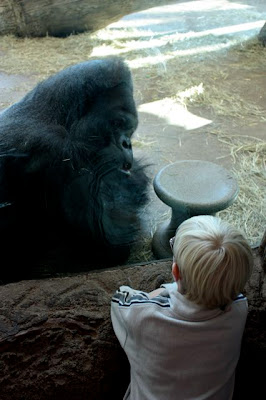On several occasions I've seen three individual YBSAs at once, swooping from tree to tree in that unique sapsucker way. Nearly all of the birds we've seen have been youngsters (birds born last spring/summer) and we can tell this by their splotchy, ill-defined plumage. On Saturday morning of Thanksgiving weekend a beautiful adult male yellow-bellied sapsucker showed up. I had stepped out onto the back deck to check the temperature and heard a light tapping coming from the nearby weeping willow tree. When the male peeked around from the trunk, the morning sun caught his red crown and throat (adult females have a white throat) and I bolted back inside the house for my camera.
In my experience, yellow-bellied sapsuckers are very quiet birds. They seem to lack the red-bellied woodpecker's zest for life, the downy and hairy's constant activity, and the flicker's flashy flight style. Sapsuckers can be easily overlooked, which is why it's so helpful to know the audible clues to their presence.
The tapping noise they make when excavating sap wells sounds like someone absent-mindedly tapping a pencil on a desk: tap-tap-tap —pause—tap-tap —pause—tap-tap-tap-tap. It is irregular in its rhythm and soft enough to go unnoticed.
Sapsuckers do vocalize quite regularly, making a soft, wheezy, descending meearr that sounds somewhat catlike. Our birds have been mewing a lot—perhaps scolding each other, trying to figure out whose territory this is going to be for the winter.
We've watched the sapsuckers make their rounds, visiting their sap wells like trappers checking their trap lines. On Saturday I noticed three other woodpecker species visiting the newly drilled sap wells in the willow: a downy, a hairy, and a red-bellied woodpecker. The male sapsucker actually tried to drive off the hairy, when it was caught poaching a drink at a ring of wells.
A few neat factoids about sapsuckers:
- They drill lines of small holes in trees, causing the tree to emit some sap to protect itself. The sapsuckers then revisit these wells on a regular basis to consume the sap and any insects attracted to it. The holes are visible scars in the tree bark, permanent evidence that a sapsucker was here at least once!
- It is thought that sapsuckers do not do much harm to healthy trees. In fact some ornithologists believe that sapsuckers prefer to drill holes in trees that are already under stress because they produce sap that is higher in certain nutrients. Still many sapsuckers are persecuted, especially by orchard owners.
- Sapsuckers don't actually "suck" sap—they lap it up with their tongues, which have short feather-like projections on the end. Sapsucker tongues function more like a brush than a straw.
- Dozens of other birds and many animals and insects will visit sapsucker wells to drink the slightly sweet sap.
- In spring, early arriving hummingbirds rely on sapsucker wells when plant nectar and insects are unavailable.
- Sapsuckers are avid migrants, with some birds reaching Central America and the islands in the Caribbean.
I've also seen our sapsuckers perch nearby our feeding stations, which are always stocked with sunflower seed, peanuts, suet, and suet dough. I'm hoping they will "tap into" this additional source of food so we can enjoy them all winter long.
























































